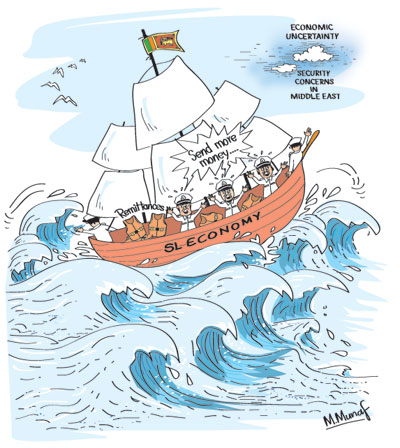Columns
Economy’s continued dependence on remittances
View(s):The country has become very much of a remittance dependent economy. Without the large amount of foreign remittances the country’s external finances would be in a far more perilous state than the current situation: imports would have had to be curtailed drastically and scarcities of essential basic items would be a feature of the country. It is difficult to visualize the state of the economy without remittances from abroad.
 Balance of payments
Balance of payments
Last Sunday’s column disclosed that despite the expected massive trade deficit this year of about US$8.5 billion, the current account of the balance of payments would be in surplus. This is mostly due to the large amount of foreign remittances from nationals living abroad. Remittances have offset as much as 87 per cent of the trade deficit in the first half of the year.
Importance of remittances
The country has become very much of a remittance dependent economy. Remittances are more than earnings from tea and garments exports and much more than foreign loans, grants and foreign direct investment. Without the large amount of foreign remittances, the external finances of the country would be in a far more serious crisis than the current situation. The consequent economic instability would setback economic growth. The country would have had to curtail imports drastically. Shortages and scarcities of essential and basic items would be inevitable.
Increasing trend
Remittances of foreign exchange by nationals living abroad into the country have been increasing over the years. In 2010 remittances amounted to US$4.1 billion. By 2014 it increased to US$7 billion. Remittances this year may be slightly higher at around US$ 7.4 billion. They were about twice the amount of loans and grants received by the country and over seven times the amount of foreign direct investment. Remittances were about 8.5 per cent of GDP in 2015.
 Trade deficit
Trade deficit
Remittances have become especially important in recent years owing to the widening trade deficits. The dependency on remittances to offset the large trade deficits from 2005 is unmistakable. In 2005 when remittances increased by about 23 per cent, they offset as much as 76.2 per cent of the trade deficit.
This trend has continued and in 2009 remittances offset the entire trade deficit. They were 6 per cent more than the trade deficit. In 2010 remittances offset as much as 85 per cent of the trade deficit. Although remittances continued to increase by 25 per cent in 2011, they offset only 53 per cent of the deficit as the trade deficit expanded to a massive US$9.7 billion.
Although the increasing trend in remittances has slowed down, they constitute a significant support to the balance of payments this year too. In the first half of this year there has been an increase of remittances, but the rate of increase has been slower at 5.6 per cent compared to over 10 per cent in some previous years. The reduced incomes in Middle Eastern countries and their security situation have been responsible for this lesser growth. Remittances from other countries have counter balanced this to some extent.
Nevertheless remittances of US$3.6 billion in the first six months offset as much as 86.7 per cent of the trade deficit in the first half of the year. Remittances were as much as 70.6 percent the value of exports and much higher than the export earnings of tea or garments. Due to the large trade deficit of US$8.5 billion expected this year too, remittances are likely to offset about 85 percent of the trade deficit. The capacity of remittances to offset as much of the trade deficit as before has diminished owing to the increasing trade deficit and slowing down of remittances.
Sources of remittances
The general impression is that remittances are from maids and other workers from the Middle East as the bulk of remittances are from Middle Eastern countries. In recent years remittances from migrant workers from the Middle East have constituted around 60 per cent of total remittances, while about 40 per cent of remittances are from the rest of the world. Significant amounts of remittances are sent from a wide range of countries and by persons of diverse occupations.
Remittances come from European countries, South Korea, North America, Australia, New Zealand, Malaysia and Singapore. There has been an increasing inflow of remittances from European Union countries and from other European countries. Inflows from North America and Asian countries constitute about 10 per cent of the total. Some of these remittances are for the upkeep of family members, purchase of land and apartments and other investments and are from professionals.
Other contributions
These expatriate remittances have an importance far beyond the support to the balance of payments. They improve living standards of the poor by enhancing their incomes, improving basic consumption and improving their housing, education and other amenities. Remittances have also enabled the start up of small business enterprises. Many families have been able to break out of their vicious cycle of poverty because of these remittances. They would not have been able to move out of poverty had they depended on wage incomes in the country.
On the other hand, there are social costs such as the break up of families, neglect of children and physical harm to workers in some countries. It is often argued that the benefits to the economy are at serious human cost to migrant workers.
Summing up
The economy is very much dependent on remittances from abroad. Without these remittances the external finances of the country would be in a pathetic state. It is fortunate that in the face of large trade deficits, the country’s balance of payments has been supported by increased remittances. Without substantial remittances the balance of payments would no doubt be in a far more serious crisis.
However with trade deficits rising to very large amounts and the prospect of remittances increasing being uncertain, it is imperative to reduce the trade deficit. Dependency on remittances could result in the country not addressing fundamental imbalances in the economy that would enable a reduced trade deficit.


Leave a Reply
Post Comment